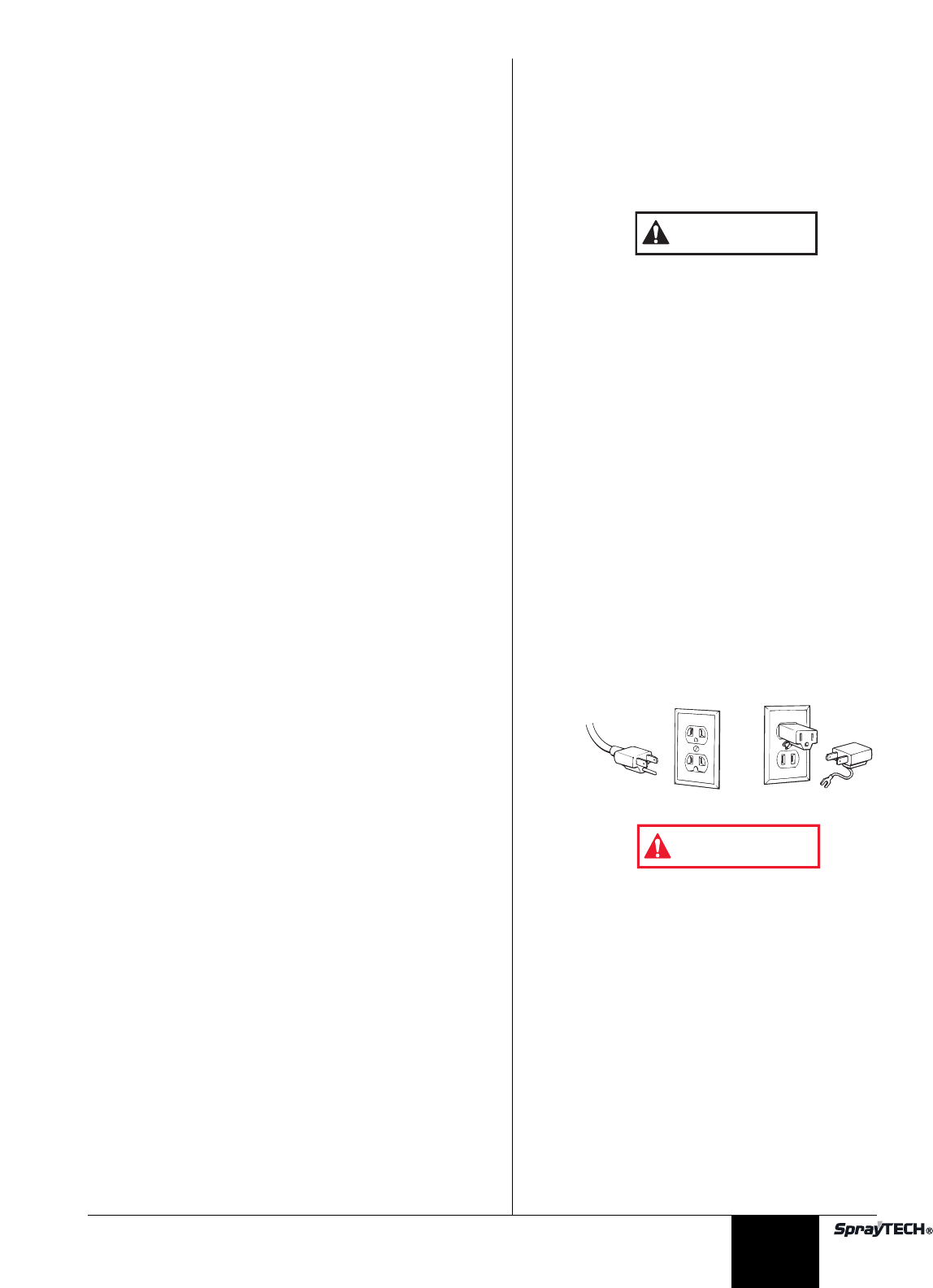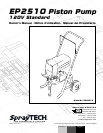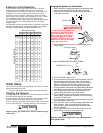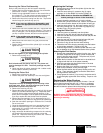
English
© SprayTECH Corporation. All rights reserved. 3
HAZARD: EXPLOSION OR FIRE - Solvent and paint fumes
can explode or ignite, causing property damage
and/or severe injury.
PREVENTION:
• Exhaust and fresh air introduction must be provided to
keep the air within the spray area free from accumulation
of flammable vapors.
• Avoid all ignition sources such as static electricity sparks,
open flames, pilot lights, hot objects, cigarettes, and
sparks from connecting and disconnecting power cords or
working light switches.
• Fire extinguishing equipment must be present and in good
working order.
• Keep the unit in a well ventilated location away from the
spray area to avoid solvent and paint fumes. The pump
contains arcing parts which emit sparks.
• High velocity flow of material through equipment may
develop static electricity. The equipment being used, as
well as objects in and around the spray area, must be
properly grounded to prevent static discharge and sparks.
• Use only conductive or grounded high pressure fluid
hoses for airless applications. Be sure that the gun is
grounded properly through hose connections.
• The power cord must be connected to a grounded circuit.
• Use extreme caution when using materials with a
flashpoint below 70° F (21° C). A fluid’s flashpoint is the
temperature at which vapors from the fluid could ignite if
exposed to a flame or spark.
• Follow the material and solvent manufacturer's safety
precautions and warnings.
• When flushing equipment use the lowest possible
pressure.
HAZARD: EXPLOSION HAZARD DUE TO INCOMPATIBLE
MATERIALS- May cause property damage or
severe injury.
PREVENTION:
• Do not use bleach.
• Do not use halogenated hydrocarbon solvents such as
methylene chloride and 1,1,1 - trichloroethane. They are
not compatible with aluminum and may cause an
explosion. If you are unsure of a material’s compatibility
with aluminum, contact your coating's supplier.
HAZARD: HAZARDOUS VAPORS - Paints, solvents,
insecticides, and other materials may be
harmful if inhaled, causing severe nausea,
fainting, or poisoning.
PREVENTION:
• Use a respirator or mask whenever there is a chance that
vapors may be inhaled. Read all instructions with the
mask to ensure that it will provide the necessary
protection against the inhalation of harmful vapors.
HAZARD: GENERAL - May cause property damage or
severe injury.
PREVENTION:
• Read all instructions and safety precautions before
operating any equipment.
• Comply with all appropriate local, state, and national
codes governing ventilation, fire prevention, and
operation.
• The United States Government Safety Standards have
been adopted under the Occupational Safety and Health
Act (OSHA). These standards, particularly part 1910 of
the General Standards and part 1926 of the Construction
Standards should be consulted.
• This high pressure airless pump is designed to be used
with manufacturer authorized parts only. When using this
pump with parts that do not comply with the minimum
specifications and safety devices of the pump
manufacturer, the user assumes all risks and liabilities.
• Before each use, check all hoses for cuts, leaks, abrasion
or bulging of cover, as well as damage or movement of
couplings. If any of these conditions exist, replace the
hose immediately. Never repair a paint hose. Replace it
with another grounded hose.
• All hoses, swivels, guns, and accessories used with this
unit must be pressure rated at or above 2750 PSI.
• Do not spray on windy days.
• Wear protective eyewear.
Use only a 3-wire extension cord that has a 3-blade
grounding plug and a 3-slot receptacle that will accept the
plug on the product. Make sure your extension cord is in
good condition. When using an extension cord, be sure
to use one heavy enough to carry the current your
product will draw. An undersized cord will cause a drop
in line voltage resulting in loss of power and overheating.
A 14 or 12 gauge cord is recommended.
Grounding Instructions
This product must be grounded. In the event of an electrical
short circuit, grounding reduces the risk of electric shock by
providing an escape wire for the electric current. This product
is equipped with a cord having a grounding wire with an
appropriate grounding plug. The plug must be plugged into an
outlet that is properly installed and grounded in accordance
with all local codes and ordinances.
This product is for use on a nominal 120 volt circuit and has a
grounding plug that looks like the plug illustrated in sketch A.
If a properly grounded outlet is not available, a temporary
adapter which looks like the adapter illustrated in sketch B and
C may be used. The temporary adapter should be used only
until a properly grounded outlet can be installed by a qualified
electrician. The green colored rigid ear lug or the grounding
wire extending from the adapter must be connected to a
permanent ground such as a properly grounded outlet box
cover. Whenever the adapter is used, it must be held in place
by a metal screw.
Improper installation of the grounding plug can result in a
risk of electric shock.
If repair or replacement of the cord or plug is necessary, do not
connect the green grounding wire to either flat blade terminal.
The wire with insulation having a green outer surface with or
without yellow stripes is the grounding wire and must be
connected to the grounding pin.
Check with a qualified electrician or serviceman if the
grounding instructions are not completely understood, or if you
are in doubt as to whether the product is properly grounded.
Do not modify the plug provided. If the plug will not fit the
outlet, have the proper outlet installed by a qualified
electrician.
WARNING
(A)
(B)
(C)
CAUTION


















